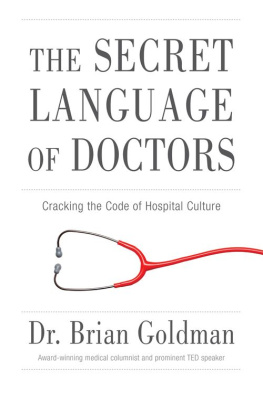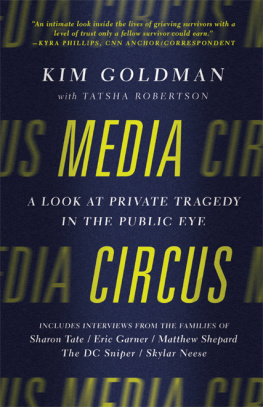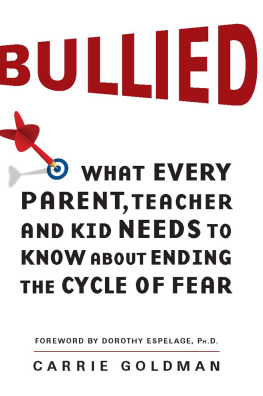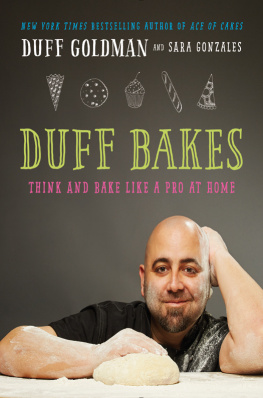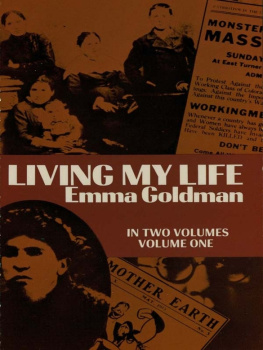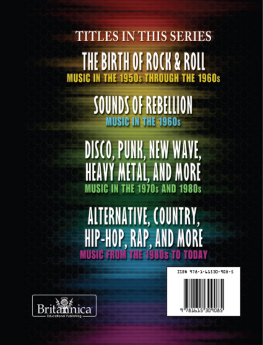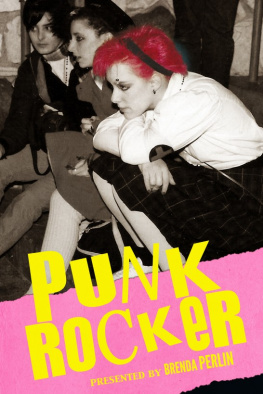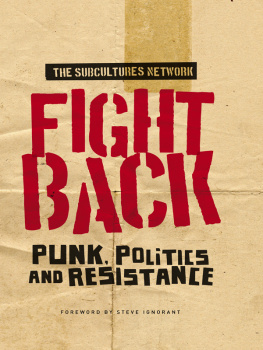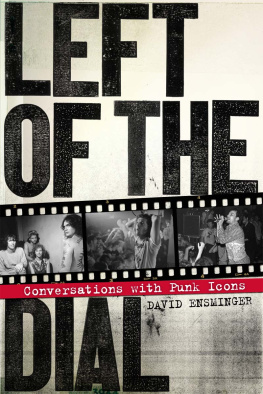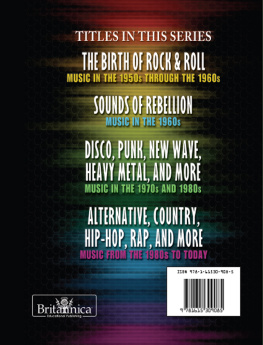ALSO BY VIVIEN GOLDMAN
BOOKS
The Book of Exodus: The Making and Meaning of Bob Marley and the Wailers Album of the Century (2006)
The Black ChordVisions of the Groove: Connections between Afro-Beats, Rhythm and Blues, Hip Hop, and More, with photographer David Corio (1999)
Pearls Delicious Jamaican Dishes: Recipes from Pearl Bells Repertoire (1992)
Kid Creole and the Coconuts: Indiscreet (1984)
Bob Marley: Soul RebelNatural Mystic, with photographer Adrian Boot (1981)
MUSIC
Resolutionary (Songs 19791982) (2016)
Its Only Money, Chantage, with Eve Blouin (1983)
Dirty Washing (1981)
The Flying Lizards (1980)
REVENGE OF THE SHE-PUNKS
A FEMINIST MUSIC HISTORY FROM POLY STYRENE TO PUSSY RIOT
Vivien Goldman

UNIVERSITY OF TEXAS PRESS
AUSTIN
Copyright 2019 by Vivien Goldman
All rights reserved
First edition, 2019
Cover and interior design by Amanda Weiss
Requests for permission to reproduce material from this work should be sent to:
PERMISSIONS
University of Texas Press
P.O. Box 7819
Austin, TX 78713-7819
utpress.utexas.edu/rp-form
LIBRARY OF CONGRESS CATALOGING-IN-PUBLICATION DATA
Names: Goldman, Vivien, author.
Title: Revenge of the she-punks : a feminist music history from Poly Styrene to Pussy Riot / Vivien Goldman.
Description: First edition. | Austin : University of Texas Press, 2019. | Includes index.
Identifiers: LCCN 2018044437
ISBN 978-1-4773-1654-2 (pbk : alk. paper)
ISBN 978-1-4773-1845-4 (library e-book)
ISBN 978-1-4773-1846-1 (non-library e-book)
Subjects: LCSH: Punk rock musicHistory and criticism. | Feminism and music. | Women punk rock musicians. | Punk rock musicians.
Classification: LCC ML82 .G64 2019 | DDC 781.66082dc23
LC record available at https://lccn.loc.gov/2018044437
DOI:10.7560/316542
CONTENTS
WOMANIFESTO
The Opening Vamp
Suddenly there seem to be an awful lot of women musicians, or women bands, in the Sounds gig guide. It seems that a womens underground is suddenly emerging overground.... When women perform a professional, hard-rocking set, with no concession to female stereotypes, theyre an automatic threat. Theyre a threat to men because they challenge male supremacy in a citadel that has never been attacked before; they threaten women who perhaps never dared acknowledge that THEY want to be onstage doing the energizing instead of watching their boyfriends do it, in passive admiration.
Vivien Goldman, Sounds, December 11, 1976
Where are you going? Where have you been?
Jayne Cortez, Maintain Control, 1986
It all began with glitter. My love of glitter started even before David Bowie shaking those clear amber plastic maracas seamed with flecks of gold in a percussion dance set named after the bandleader, Victor Sylvester. The scene is set in North West London, early 1960s. My father, Max, plays his violin; big sister, Judy, is on keyboards, that is, our piano; myself and middle sister, Susan, hold down the percussion and sing. All three of us girls do. Judy now says I had it easy because I was the youngest and she fought the battles to stay out late. But looking back, I feel like I was always the one being told what to doexcept for when we were singing. Then, it was understood that I was the one who heard the harmonies and could tell them the notes.
Music has been my dance partner through life. Merrily, melodramatically, we have waltzed through a whirl of personae: (briefly) press officer, journalist, author, songwriter, singer, producer, club-runner, documentarian, blogger, editor, video/TV/radio writer, director, host and producer, publisher.
My numerous adventures were all instructive. Talked into it against my better judgement, I dabbled in management (very briefly) steering the mid-1970s careers of Generation X (hello, Billy Idol and Tony James!) and the girl duo Snatch, whose Patti Palladin and Judy Nylon cut the plea of the frustrated female artist: All I want is all you know. When I dropped out of recording (about which theres more anon), I went into independent television as a producer and director in the early 1980s boom. I got to mix up international music on the TV show I devised with a partner, Big World Caf. Videos I directed for to-be-classics back then are in museums today, like rappers Eric B & Rakims I Aint No Joke and Jamaicas Chaka Demus & Pliers Murder She Wrote. Because of music, I stood alone before the guns of a secret army division in Lagos, Nigeria. Once I carried on dancing as bullets flew around me in a Jamaican DJ session because I thought the sounds were the current synth drum beat and the people crouching around me were doing the Get Flat dance craze. Afterwards, I was baffled when people congratulated my courage. Eventually, I earned the nom dacademe the Punk Professor as a long-serving Adjunct Professor at NYUs Tisch School of the Arts Clive Davis Institute of Recorded Music.
* * *
But the trip to writing this book really began in 1975, writing the above article on women in rock for Sounds, the feisty underdog punk rock weekly I had just joined as a writer. By the 1990s that angle had become a predictable annual staple of rock magazines, especially those that rarely covered freethinking She-Punks. But back then, I had never seen such a piece, nor indeed such women. Puzzlement was my overriding feeling as I pushed my way nearer to the front of the London club stage. I was a recent graduate from Warwick, one of Britains radical new plateglass universities. The noted feminist theorist Germaine Greer was my tutor. She disapproved of my partying all term and cramming my studies at exam time. But what did she expect? We loved making music, but I had rarely raved, coming from my rather orthodox Jewish family. The first girl to go to university, I also seemed to be the only one not to want marriage to be my next step in the dance. Instead, I was consumed with a raging curiosity: What could possibly be out there for a weirdo like me? There were no examples, no mentors to look to or advise me.
And now here I was witnessing this strange apparition... a long-haired guitarist in jeans, who as I drew closer I realized wasa woman! Playing power chords! I had never seen a girl play on stage in a band before. The shock was such that I had to talk about it with my colleagues at Sounds. And so I published my first Women in Rock story, which, as you can see, would not be my last. Pop and rock had only really existed for a quarter century, thus making it easy to become an expert. It would have been hard then to imagine that I would turn out to be a music lifer.
Despite its punk identification, Sounds was typical of the world of work in the London music industry. Even when I had wo/manhandled my way to features editor, conducting editorial meetings meant dodging a barrage of attempted gender/career genocidemy writers, all white and all boys, insisted: Women dont buy music! Women dont make music! Women dont read music papers! The subtext was: Even if they happen to, theyre so irrelevant that why bother to write about them?
They had all internalized diarist Samuel Johnsons sick eighteenth-century quip: A womans preaching is like a dogs walking on his hind legs. It is not done well; but you are surprised to find it done at all. It was natural to bitch about this silliness as I was still having to deal with it, two hundred years on. They were my writers, my team, but those patronizing attitudes also made them my gender enemy. So, what am I then, chopped vinyl? I fumed, often aloud but not always, as I had a weekly paper to fill.
Next page

